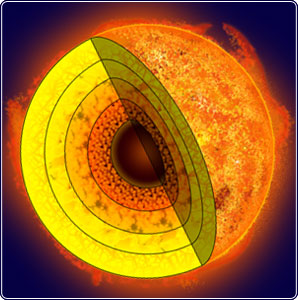
Welcome to the Asteroseismic Modeling Portal
The Asteroseismic Modeling Portal (AMP) provides a web-based interface for astronomers to use the Aarhus Stellar Evolution Code (ASTEC) coupled with a parallel genetic algorithm (MPIKAIA) to derive the properties of Sun-like stars from observations of their solar-like oscillation frequencies.
What can I do with AMP?
Everyone can browse the catalog of runs to find data about stars that have been modeled with AMP. You can find basic properties of the stars, such as their radius, mass, and age, and you can download a Hertzsprung-Russell (HR) diagram that shows the star's temperature and luminosity during its lifetime.
Scientists can use AMP to do two things:
- Observable parameter optimization. In an optimization run, a scientist specifies observable properties, such as pulsation frequencies, and a genetic algorithm is used to identify the stellar model that best fits the observed data. An optimization run makes extensive usage of XSEDE computational resources and consumes about 20,000 CPU hours.
- Direct ASTEC model evaluation. In a direct model run, a scientist specifies a star's parameters, and a model is generated using ASTEC. Data about the hypothetical star, including Echelle and HR diagrams, are produced for inspection. A direct model evaluation takes about 15 minutes to run.
For more information about AMP, please see About AMP and the AMP User Guide.
AMP Supports Kepler and TESS Science
The Kepler satellite revolutionized asteroseismic observations of solar-type stars, and the TESS mission is now extending this success to bright stars all around the sky. A uniform analysis of the asteroseismic data helps to minimize systematic errors between the properties derived for different stars, which is facilitated by this XSEDE-based community modeling tool.
AMP is an XSEDE Science Gateway
The genetic algorithm that performs the asteroseismology science requires immense amounts of computational time to run. AMP uses XSEDE computational resources, including Stampede at the Texas Advanced Computing Center (TACC).





